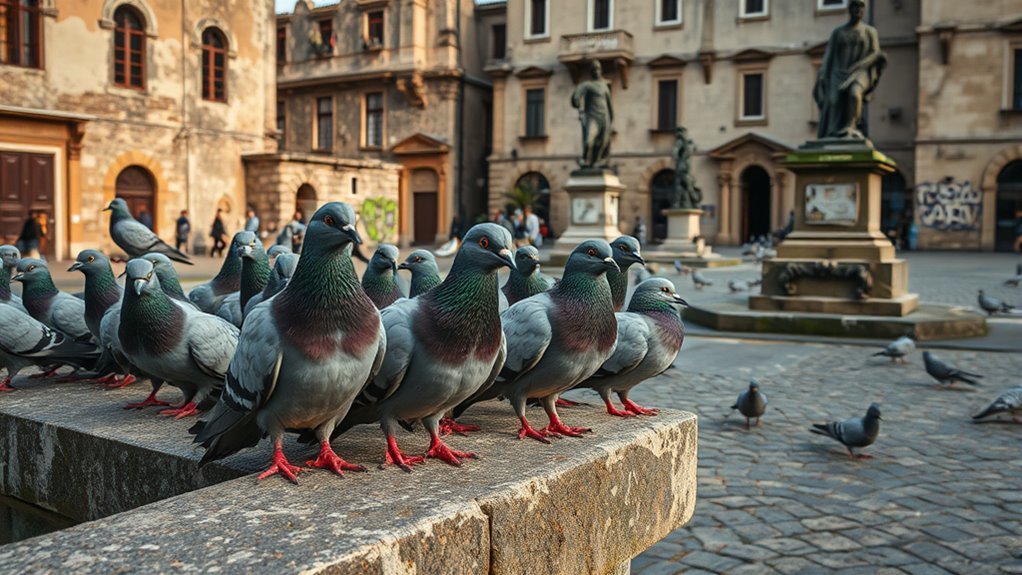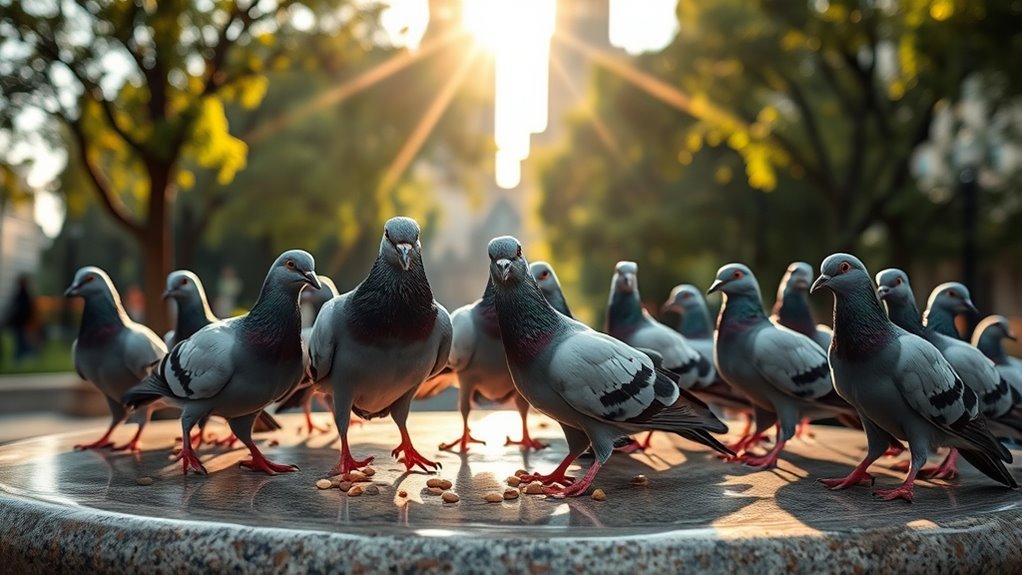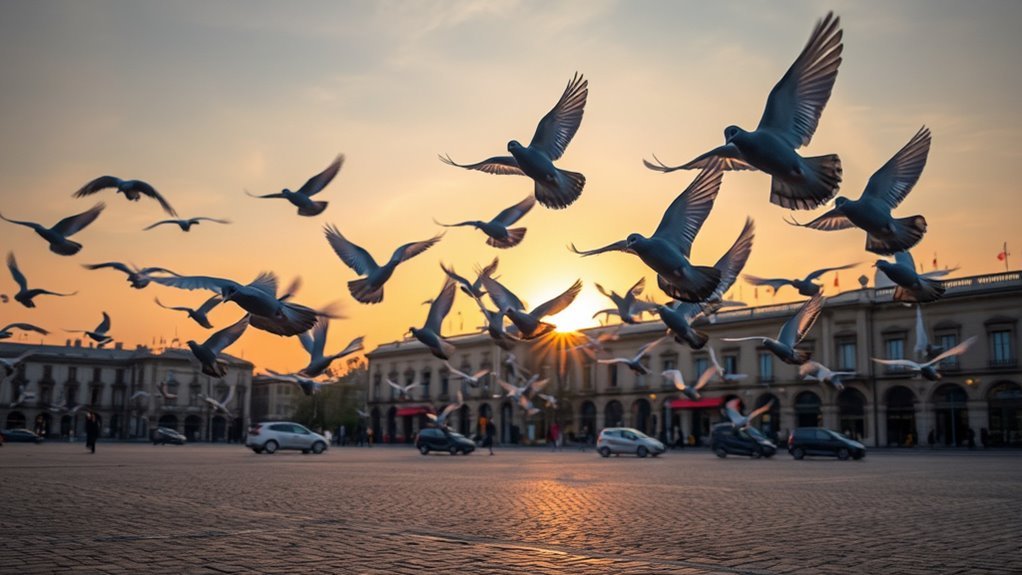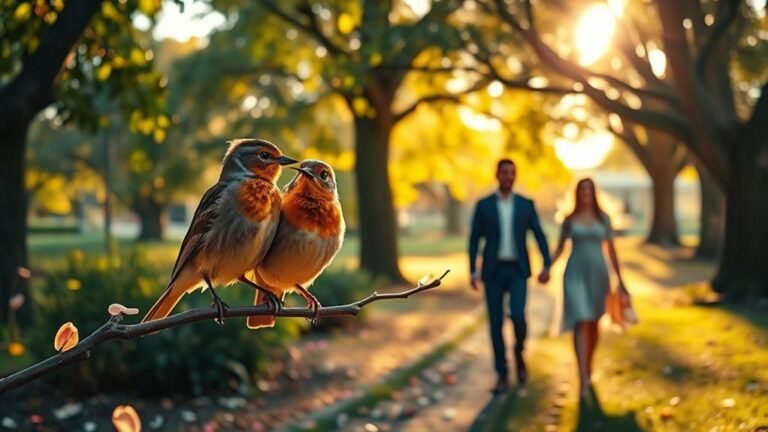Pigeon Birds: Understanding Their Meaning in Context
Pigeon birds are important yet often ignored. These birds have played key roles in history and culture. They acted as messengers, symbolized various meanings, and adapted well to city life. Learning about pigeons shows their historical role and their impact on nature and the environment. As cities change, it is essential to understand pigeons. This understanding could lead to important insights for conservation and how humans connect with nature. What roles do pigeons play in today's society?
Key Takeaways
- Pigeons symbolize peace, loyalty, and family love across various cultures, particularly in art and literature, representing harmony and urban belonging.
- In Christianity, pigeons are doves that signify the Holy Spirit, while in Islam, they hold sacred relevance often associated with mosques.
- Pigeons assist urban ecology by controlling insect populations, aiding in pollination, and enhancing biodiversity in city environments.
- Their adaptability to urban habitats makes pigeons important indicators of urban biodiversity and environmental health in cities.
- Conservation strategies for pigeons include habitat preservation, responsible population management, and raising community awareness about their ecological contributions.
Historical Significance of Pigeons

Pigeons are often seen as common birds today, but they've shaped human history in significant ways. They were especially valuable as messengers during wars. People domesticated pigeons thousands of years ago, forming a strong connection between humans and these birds.
Their ability to find their way home made them essential for military communication, allowing messages to travel over long distances.
During major conflicts like World War I and II, pigeons delivered important information, earning recognition for their service. Breeders focused on enhancing specific traits in pigeons, improving their skills and adaptability.
Recognizing the historical role of pigeons deepens our appreciation for them. These birds moved beyond simple livestock; they became vital in stories of human courage and connection.
Pigeons in Art and Literature
Pigeons symbolize peace, resilience, and communication in art and literature. Artists and writers often use them to reflect these themes.
In literature, pigeons represent longing and connection, helping characters express emotions and bridge distances.
Visual artists include pigeons in their work to show harmony, placing them alongside urban landscapes to highlight the contrast between nature and city life. This relationship creates a sense of belonging for viewers.
Through art and literature, pigeons help us understand human feelings and our desire for unity and expression. Their presence caters to both our emotional and aesthetic experiences, making them a powerful symbol in creative works.
Cultural Symbolism of Pigeons

Pigeons symbolize various meanings in different cultures. Many people view these birds as symbols of peace and hope. In religious contexts, pigeons often act as messengers from a higher power. Their symbolism can change; some cultures see them as symbols of loyalty and family, while others see them as representing freedom and resilience.
In ancient Greece, pigeons were associated with Aphrodite and stood for love and beauty.
In urban areas, pigeons illustrate adaptability and survival. These meanings resonate with many people, creating connections across cultures.
Understanding the significance of pigeons helps us appreciate their role in societies around the world.
Pigeons as Messengers Throughout History
Throughout history, pigeons have served as important messengers, especially during wars. Carrier pigeons were trained to deliver messages over long distances.
During World War I and II, they played a vital role in communications. Their speed and endurance often helped save lives. Unlike other methods of communication, pigeons offered a secure option that was hard to intercept.
They built strong bonds with humans, creating trust and loyalty. Their unique homing ability allowed them to find their way back to their nests.
Understanding their historical role helps us see pigeons as more than just birds; they were key tools in communication.
Spiritual Representations of Pigeons

Pigeons have served as messengers throughout history, leading to their spiritual significance in many cultures. Many traditions see pigeons as symbols of peace and hope.
They're often considered divine messengers that connect different realms. Their gentle nature and skill in covering long distances relate to spiritual guidance.
When you see a pigeon, view it as a reminder to find inner peace and connect with your higher self.
Their cooperative behavior emphasizes the importance of community and relationships in your spiritual journey.
Understanding the spiritual meanings of pigeons can enhance your appreciation of their presence in your life and highlight the connection among all beings.
Pigeons in Religious Contexts
Pigeons appear in many religious beliefs, often symbolizing deeper meanings. Here are some ways they're represented in various traditions:
- In Christianity, a dove represents the Holy Spirit. It stands for purity and a connection to the divine.
- In Islam, pigeons are respected and considered sacred. Their nests can often be found in old mosques.
- In Hinduism, pigeons are mentioned in texts related to sacrifices, reflecting acts of devotion and prayer.
These examples show how pigeons symbolize spirituality and connection across different cultures, adding rich layers to their meanings.
The Role of Pigeons in Urban Ecology
Pigeons play a vital role in urban ecology as cities grow. These birds adapt well to urban environments and increase wildlife diversity. Pigeons help control insect populations through their feeding habits. Their nesting also aids in pollination and seed dispersal, promoting biodiversity and stabilizing local ecosystems.
Additionally, pigeons can assist in pest management, reducing the need for chemical solutions. However, overpopulation can lead to public health issues, complicating their interactions with humans.
Understanding the role of pigeons in cities is important for coexisting peacefully with nature. By recognizing their benefits, city dwellers can help ensure that pigeons contribute positively to urban life.
Pigeons and Human Connection
Pigeons contribute to urban ecosystems and connect with humans. These birds exhibit behaviors that help city dwellers feel a sense of community.
- Adaptability: Urban pigeons live well in various environments. They show resilience in different conditions.
- Social Dynamics: Their interactions reflect social structures similar to human groups.
- Cultural Significance: Pigeons often symbolize peace and friendship in cities.
Interacting with pigeons allows you to see the development of significant relationships. These connections enhance your appreciation for urban wildlife and emphasize our shared environment.
Understanding these relationships enriches your view of urban life, encouraging a deeper bond with the living world around you.
Myths and Folklore Surrounding Pigeons
Pigeons appear in myths and folklore across many cultures. They symbolize peace, hope, and loyalty due to their role as message carriers.
In stories, pigeons often act as guides for lost souls or represent new beginnings. Some cultures view pigeons as omens that signal events in life or love.
These narratives show how pigeons connect communities through shared beliefs and stories. By appreciating these tales, we can better understand the significance of pigeons in our lives.
The Scientific Importance of Pigeons
Pigeons have significant scientific importance. They adapt well to urban environments, offering insights into bird behavior and physiology. This makes them useful for studying evolution.
- Pigeons have unique genetics that can help scientists understand disease resistance.
- Scientists study pigeon migration patterns to learn about navigation techniques.
- Research on pigeon reproduction helps explain how domestication happened.
By studying pigeons, researchers can learn about broader ecological dynamics.
Pigeons also demonstrate how species can adapt to urban settings, which is vital as habitats change.
These findings promote collaboration in the scientific community, helping people appreciate the value of bird life.
Pigeons in Modern Culture and Media
In city life, few birds are as interesting as pigeons. They appear often in modern culture and media. Their images can symbolize peace, love, and urban strength. Pigeon symbolism shows our complicated bond with these birds.
You may see pigeons in films, ads, and social media. They often stand for community and unity. This is different from earlier views that saw them as pests.
As you look at pigeons in memes or art, think about how they show adaptability. They make us reflect on belonging and survival. Pigeons are more than just birds; they represent our urban experience.
Conservation and the Future of Pigeons
Many people view pigeons as common city birds, but they play an important role in urban biodiversity. You can help protect them by focusing on three key areas:
- Help preserve their habitats.
- Support population management strategies.
- Raise awareness about their environmental impact.
Pigeons adapt well to city life and are vital to urban ecosystems. Using ethical breeding programs can help keep their genetic diversity strong.
By understanding the significance of pigeons in cities, you can support conservation efforts that match habitat preservation. Together, we can build a future where these resilient birds thrive, enriching our cities and improving our environment.
Join us in promoting initiatives that balance city development with the ecological role of pigeons.
Frequently Asked Questions
How Do Pigeons Communicate With Each Other?
Pigeons communicate using cooing sounds and body language. Their cooing varies in pitch and rhythm, indicating different emotions. For example, a soft coo can mean comfort, while a loud coo may signal alarm. Body movements, like puffing up feathers or bowing, also convey messages. By watching these behaviors, you can understand what pigeons feel and want. This knowledge helps you appreciate their social interactions and relationships.
What Are the Different Breeds of Pigeons?
Pigeons come in various breeds, each with unique traits. Some popular breeds include the elegant Fantail and the Racing Homer, which is known for its speed and endurance. Pigeon colors also vary widely, adding to their charm. Understanding these breeds helps you appreciate these fascinating birds even more.
How Long Do Pigeons Typically Live?
Pigeons usually live between 5 to 15 years. Their lifespan depends on genetics, environment, and diet. By understanding these factors, you can provide better care for your pet pigeon. Good care may help your pigeon live a longer life.
What Do Pigeons Eat in Urban Environments?
In urban environments, pigeons eat a variety of foods. Their diet includes discarded items, seeds, and grains. Pigeons adapt well to their surroundings and thrive alongside people. This ability to find food in cities shows their resilience. Watching pigeons forage can be fascinating, as they utilize whatever is available to survive.
Can Pigeons Recognize Human Faces?
Pigeons can recognize human faces. They have the ability to identify familiar people and respond accordingly. This skill helps them engage better in their interactions with humans. Pigeons are attentive to human behaviors and expressions, which makes them surprisingly perceptive.

Hello, I’m Emily Price, the founder of Birds Affection. As a passionate bird enthusiast and spiritual seeker, I’ve always been fascinated by the symbolic meanings and mystical connections between birds and our lives. On this website, I share my knowledge and insights on the spiritual significance of various bird species, exploring their roles as messengers, guides, and teachers. Through my writing, I aim to inspire and educate others on the profound wisdom and beauty that birds bring to our world. Join me on this journey as we delve into the enchanting realm of bird symbolism and discover the hidden meanings behind these magnificent creatures.







